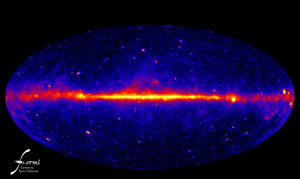
Handy Links
SLAC News Center
SLAC Today
- Subscribe
- Archives: Feb 2006-May 20, 2011
- Archives: May 23, 2011 and later
- Submit Feedback or Story Ideas
- About SLAC Today
SLAC News
Lab News
- Interactions
- Lightsources.org
- ILC NewsLine
- Int'l Science Grid This Week
- Fermilab Today
- Berkeley Lab News
- @brookhaven TODAY
- DOE Pulse
- CERN Courier
- DESY inForm
- US / LHC
SLAC Links
- Emergency
- Safety
- Policy Repository
- Site Entry Form

- Site Maps
- M & O Review
- Computing Status & Calendar
- SLAC Colloquium
- SLACspeak
- SLACspace
- SLAC Logo
- Café Menu
- Flea Market
- Web E-mail
- Marguerite Shuttle
- Discount Commuter Passes
-
Award Reporting Form
- SPIRES
- SciDoc
- Activity Groups
- Library
Stanford
Around the Bay
Fermi Telescope Celebrates One Year of ScienceThis view of the gamma-ray sky, constructed from one year of LAT observations, is the best view of the extreme universe to date. The map shows the rate at which the LAT detects gamma rays with energies above 300 million electron volts—about 120 million times the energy of visible light—from different sky directions. Brighter colors equal higher rates. (Image: NASA/DOE/Fermi LAT Collaboration.)
Just over a year after the Fermi Gamma-ray Space Telescope began taking science data, the collaboration is celebrating its many noteworthy results. "With Fermi, we're seeing the gamma-ray sky at timescales we've never been able to probe before; we also see an energy range previously inaccessible to us," Fermi Project Scientist Julie McEnery said yesterday during a NASA media event publicizing the first year of Fermi telescope results. "With these missing pieces, we're finding many new things in the sky." As the highest energy form of light, gamma rays tell researchers about some of the fiercest processes in the universe—including incredibly dense stars called pulsars that send flashes toward Earth as they spin; jets emanating from the centers of galaxies, called blazars, that flare with unbelievable brightness; and the universe’s most luminous—yet mysterious—explosions, called gamma-ray bursts. In its first year, the telescope observed approximately 1000 gamma-ray sources. These observations include more than ten times the number of blazars previously identified, and the most sensitive measurements of very high-energy gamma-ray bursts over a wide range of energies. The Fermi telescope also discovered pulsars that pulse only in gamma rays and the first "millisecond" pulsars—pulsars that flash extraordinarily often—to be seen in gamma rays. These observations, along with many others, offer new insight into the physical processes by which these cosmic objects operate. They may also spark evidence for—or against—theories including dark matter and quantum gravity. (Nature published a Fermi telescope paper presenting limits related to quantum gravity just yesterday.) The Fermi spacecraft carries two instruments, the Large Area Telescope and Gamma-ray Burst Monitor. The LAT, which was managed and assembled at SLAC, scans the high-energy gamma-ray sky, taking in a panoptic view of the sky with energies from 5 million to more than 50 billion times that of visible light every three hours. The Instrument Science Operations Center at SLAC processes all data beamed down to Earth from the LAT's 350-mile-high orbit, converting the raw information into a form that scientists can analyze. Meanwhile, the GBM views the whole sky at once—except, of course, the portion obscured by the Earth—in its hunt for gamma-ray bursts and other transient phenomena in the universe. The GBM measures these bursts in an energy range 2000 to 10 million times that of visible light, and re-orients the spacecraft so that the LAT can observe the high-energy component of the bursts. Together, the instruments offer the most sensitive and complete view to date of the gamma-ray sky. "After one year of science operations, the impact of Fermi discovery is very high," LAT Analysis Coordinator Nicola Omodei said at last Monday's colloquium, Fermi Large Area Telescope's Greatest Hits (So Far). "We've had a lot of fun and a very productive year." —Kelen Tuttle |
